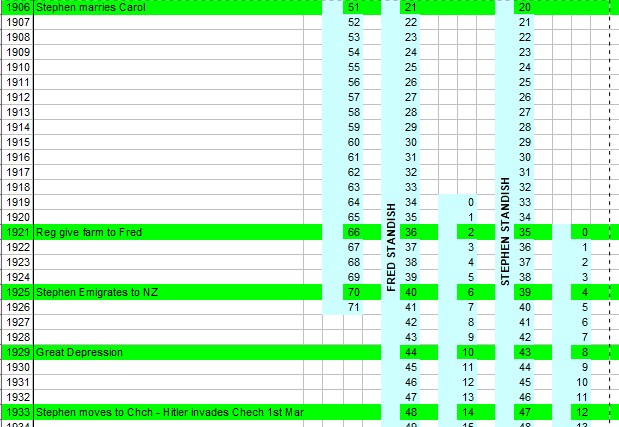As I have said on the home page, Historical Fiction needs to be historically accurate. Without the accuracy, you might as well be writing straight fiction. Personally, unless you are writing about a totally fictitious place, like say another planet or dimension, there is probably something that is real about your story. So why not do the research and make it real?
How much has to be accurate? Everything. If you talk about an old truck, make sure that truck was, available in that year, and was released in that area.
Don’t just assume. I have had several comments along the lines of;
“We googled a place or an event. The fact that the information was accurate made the whole story feel more real!”
I believe that the key to believability is a;
TIMELINE
How do you do all that? … Create a timeline.
This to me is an essential step. It literally becomes your control of the story. Let me show you how.

Create a spreadsheet. The first column should cover the time period from at least ten years before.
The next column or columns can be headed events. Let me give you a sample out of the Kennards Valley timeline.
Mike (3rd blue column) is born in 1919. At this time Reginald (1st blue column) is 64 and his son Fred, Mikes father (Third blue column) is 34.
When the Great Depression breaks out, Reginald is dead, Fred is 44, and Mike is 10.
RESEARCH
As you can see from the above at any one date you can see the age of all the characters. This ensures that Mike does not get married in 1931, at the age of 12.
Do your research. In Kennard’s Valley, there is a severe snowstorm. In the story, it catches out Stephen and Susan as they return from their honeymoon. This is where the timeline is crucial.
- Research the storm. 14th July 1945
- Enter it into the timeline.
I had to adjust the birth dates of both Stephen and Susan to enable their return from their honeymoon to make everything fit this event. You may have to alter all sorts of things to enable a historical event to co-inside with the story. Luckily WW2 and this event fitted Stephens time frame, else I would have to look for another historical event to incorporate.
If you don’t like research, then write non-historical fiction, then you can have pretty much free reign. I enjoy it, so historical fiction is my niche.
Other than time-related issues, you also need to be accurate on other things as well. In the sequel, a cave is enlarged using explosives. I am still researching this as all the information like setting the detonators, placing the charges, and safe distances to hide etc all have to be accurate, at least they do to have to satisfy me.
In another book I am writing, a detective gets involved in investigating an old espionage plot. He travels both to outback Aussie and to Washington DC to visit the FBI Headquarters. I googled and found a small airline that actually flies into that area. I then emailed them and asked when they fly, where from only too happy to help. They will get an acknowledgment when the book is published of course. But the details will be included in the story as required.
Also, I used Google Earth to virtually drive from a fictitious hotel in Washington to the FBI HQ. You can do it. Actually, move down the road looking left and right at the scenery in 3d. That trip will also be described in part. It will be accurate as though I have been there, even though I haven’t. The point is that if anyone from Washington reads the book, it will be real for them.
Because that’s what makes Historical Fiction so neat.